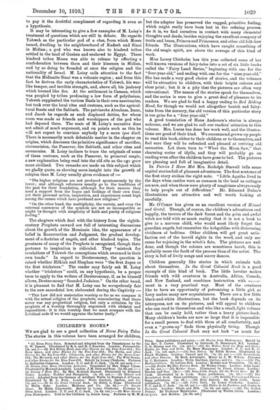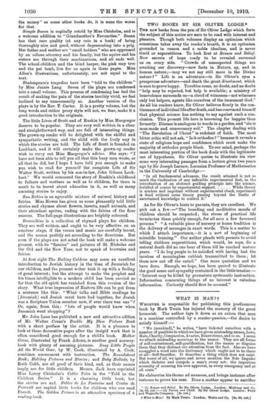CHILDREN'S BOOKS.*
WE are glad to see a good collection of Norse Fairy Tales. The stories in this volume have been arranged for children,
• (1) Norse Fairy Tales. Selected and Adapted from the Translations by Sir G. W. Dement. Illustrated by R. L. and H. J. Knowles. London : Freemturtle. [6s. net.]-(2) Red Riding Hood, and other Stories for the Four-Year-Old ; The Snow Queen, and other Stories for the Five-Year-Old; The Storks, and other Stories for the Six-Year-Old; Cinderella, and other Stories for the Seven-Year- Old; The Mermaid, and other Stories for the Right-Year-Old ; The Wild Swans, and other Stories for the Nine-Year-Old. Retold by Loney Chisholm. Pictures by Katharine Cameron. London : T. C. and E. C. Jack. [ls. 6d. net each.]- (3) Stories from Hans Christian Andersen. Translated by Mrs. Edgar Lucas. Illustrated by Maxwell Armfleld. London : J. M. Dent and Sons. (7s. 6d. net.] -
(4) Fairies I Have Met. By Mrs. Rodolph Stawell. Illustrated by Edmund Dalac. London : Hodder and Stoughton. [3s. 6d. net.]-(5) Mosel and Gretel. Adapted from the German of Adelheid Wette by /forreys J. O'Conor. Illustrated by M. L. Kirk. London : Wells Gardner, Darton, and Co. [5s. net.]-(6) In the Great Colonial Bush. By Edith L. Elias. Illustrated by Helen Gray. London : Methuen and Co. [2s. 6d.]-(7) Simple Susan. By Maria Edgeworth. Retold by Loney Chisholm. Pictures by Olive Allen. London : T. E. and E. C. Jack. [ls. 6d. net.]-(8) More Stones
from Shakespeare. Told to the Children by Jeanie Lang. Pictures by M. M.31 ik13j 3S1 and Holden. [2s. net.]
but the adapter has preserved the rugged, primitive feeling, which might easily have been lost in the refining process. As it is, we find ourselves in contact with many elemental thoughts and deeds, besides enjoying the excellent company of trolls and bears, Princes and Princesses, and other old folk-lore friends. The illustrations, which have caught something of the old magic spirit, are above the average of this kind of work.
Miss Louey Chisholm has this year collected some of her well-known versions of fairy-tales into a set of six little books called the "Fairy Land Series," beginning with one for the "four-year-old," and ending with one for the "nine-year-old." She has made a very good choice of stories, and the volumes will be attractive to children, with their bright colours and clear print ; but it is a pity that the pictures are often very conventional. The names of the stories speak for themselves, and the series is sure to give a great deal of pleasure to its readers. We are glad to find a happy ending to Red Riding Hood, for though we would not altogether banish sad fairy- tales from the nursery, the old version of this particular story is too grim for a " four-year-old."
A good translation of Hans Andersen's stories is always welcome, and we are glad to call our readers' attention to this volume. Mrs. Lucas has done her work well, and the illustra- tions are good of their kind. We recommend grown-up people to read this book, either to their children or to themselves, and feel sure they will be refreshed and pleased at reviving old memories. Let them turn to " What the Moon Saw," that charming series of idylls, and they will probably go on reading even after the children have gone to bed. The pictures are pleasing and full of imaginative detail.
In Fairies I Have Met Mrs. Rodolph Stawell tells some capital stories full of pleasant adventures. The first sentence of the first story strikes the right note. "Little Agatha lived in the days when castles were as common in the land as cottages are now, and when there were plenty of magicians always ready to help people out of difficulties." Mr. Edmund Dulac's illustrations are attractive and well worth looking at carefully.
Mr. O'Conor has given us an excellent version of Hansel and Gretel. Though, of course, the children's adventures end happily, the terrors of the dark forest and the grim and awful witch are told with so much reality that it is not a book to give to a. nervous child, who would most likely forget the guardian angels, but remember the hobgoblins with distressing vividness at bedtime. Other children will get great satis- faction out of the horrid sights in the wood, and only see cause for rejoicing in the witch's fate. The pictures are well done, and though the colours are sometimes harsh, this is probably more the fault of the process than of the artist. The story is full of lively songs and merry dances.
Children generally like stories in which animals talk about themselves. In the Great Colonial Bush is a good example of this kind of book. The little heroine makes friends with wild creatures in Australia, Africa, Canada, and New Zealand, and combines instruction with atuittac- ment in a very practical way. Most of the creatures like to have an opportunity of patronising a little girl, so Lucy makes many new acquaintances. There are a few little black-and-white illustrations, but the book depends on its letterpress, not on its pictures, and will appeal to children who can read to themselves and who like a small, light volume that can be easily held, rather than a heavy picture-book. Many children's books are now so large that it is impossible for a small person to deal with them at all comfortably, and even a " grown-up" finds them physically tiring. Though In the Great Colonial Bush may not look " as much for Price. Same publishers and price.-(9) Stories from Shakespeare. Retold by the Rev. T. Carter. Illustrated by Gertrude D. Hammond, RI, London: G. G. Harrap and Co. Pe. net.)-(10) Sir Walter Scott for Boys and Girls ; Ruskin for Boys and Girls. By Mary Macgregor. London : T. C. and E. C. Jack. fls. net each.]-(11) Sun Babies. Br Edith Howes. Illustrated by Frank Watkins. London: Cassell and Co. [3s. 6d. net. i-(12) Brownikins, and other Fancies. By Ruth Arkwright. Music by J. W. Wilson. Pictures by C. Robinson. London: Wells Gardner, Diatom, and Co. [6s.]-(13) The Boiling Caldron. By Lettice Bell. London : Hodder and Stoughton. [3a. 6th] -(14) Buckle My Shoe Picture Book. By Walter Crane. London : John Lane. [4e. 641. net.]-(15) Mother Goose. Illustrated by Frank Adams. London : lilackie and. Son. [2s.]-(16) Busy Little People All the World Over. By W. Cook. Illustrated by A. Cook. Same publishers. [3s. 6d.]-(171 The Roundabout Book. Same publishers. [ls.]-(18) Holiday Pictures and Stories. Same publishers. [Is. 6c1.]-(19) Baby Ballads. By Ruth Cobb. Same publishers. [Is. 6d.]-(20) Celtic Tales. By Loney Chisholm. London : T. C. and E. C. Jack. [ls. 6d. net.]--(21) Fables de La Fontaine and Conies de Perrault. London : Siegle and Hill. Els. 6d. net each.1-(22) The Golden Primer. By Professor Meikle 'ohn. Illustrated by Walter Crane. London :
the money" as some other books do, R is none the worse for that.
Simple Susan is capitally retold by Miss Chisholm, and is a welcome addition to " Grandmother's Favourites." Susan has that rare quality (at any rate in a book) of being thoroughly nice and good, without degenerating into a prig. Her father and mother are "small holders " who are oppressed by an odious attorney and his family, but the squire and his sisters see through their machinations, and all ends well. The school-children and the blind harper, the pink may tree and the pet lamb, live for us again in these pages. Miss Allen's illustrations, unfortunately, are not equal to the text.
Shakespeare's tragedies have been "told to the children" by Miss Jeanie Lang. - Seven of the plays are condensed into a small volume. This process of condensing has had the result of making the pain of the stories terribly vivid, we feel inclined to say unnecessarily so. Another version of the plays is by the Rev. T. Carter. It is a pretty volume, but the long words and rather prosy style will not, we fear, make it a good introduction to the originals.
The little Lives of Scott and of Ruskin by Miss Macgregor deserve to be popular. They are very well written in a clear and straightforward way, and are full of interesting things. The grown-up reader will be delighted with the skilful and sympathetic writing, and the child with the lively way in which the stories are told. The Life of Scott is founded on Lockhart, and it will certainly make the grown-up reader wish to carry out Miss Macgregor's advice. She says: "I have not been able to tell you all that this busy man wrote, or all that he did, but I hope I have told you enough to make you wish to read for yourself the complete Life of Sir Walter Scott, written by his son-in-law, John Gibson Lock- hart." We would commend the story of Ruskin's childhood to fathers and mothers as well as to children, for there is much to be learnt about education in it, as well as many amusing stories to enjoy.
Sun Babies is an agreeable mixture of natural history and fairies. Miss Howes has given us some pleasantly told little stories and rhymes about flowers, insects, small animals, and their attendant sprites, ending with the fairies of the four seasons. The full-page illustrations are brightly coloured.
Brownikins is a collection of rhymed plays for children. They are well written, and ought to be very effective on an amateur stage, if the verses and music are carefully learnt, and the scenes prettily set according to the directions. But even if the plays are not acted the book will make a. welcome present, with its "fancies" and pictures of St. Nicholas and the Old and the New Year, not to speak of brownies and fairies.
At first sight The Boiling Caldron may seem an excellent introduction to Jewish history in the time of Jeremiah for our children, and the present writer took it up with a feeling of great interest; but the attempt to make the prophet and his times intelligible to a modern child has been carried so far that the old spirit has vanished from this version of the story. What true impression of Eastern life can be got from a sentence like this : "What talks and Bible readings he [Jeremiah] and Josiah must have had together, for Josiah was a Scripture Union member now, if ever there was one " ? Or, again, from this : " lots of people would know when Jeremiah went shopping"?
Mr. John Lane has published a new and attractive edition of Mr. Walter Crane's Buckle My Shoe Picture Book with a short preface by the artist. It is a pleasure to look at these decorative pages after the insipid work that is often considered good enough for a child's book. Mother Goose, illustrated by Frank Adams, is another good nursery- book with plenty of amusing pictures. Busy Little People All the World Over, by W. Cook, illustrated by A. Cook, combines amusement with instruction. The Roundabout Book; Holiday Pictures and Stories ; and Baby Ballads, by Ruth Cobb, are all good of their kind, and, as their names imply, are for little children. Messrs. Jack have reprinted Miss Loney Chisholm's Celtic Tales in the "Told to the Children Series." It is a charming little book, but the stories are sad. Fables de La Fontaine and Contes de Perrault are capital little books for children who can read French. The Golden Primer is an attractive specimen of a read in g- book.



























































 Previous page
Previous page